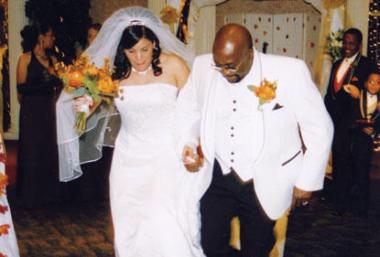When Margie and Reggie Cole chose November 11, 2006 as their wedding day, they faced several challenges, not the least of which was time. Margie didn’t start planning the wedding, didn’t even book the reception hall, until two months before the chosen date.
Fortunately, Margie had confidence in her ability to get organized, plan the wedding and pull things together in a hurry. And she got great news when she learned that Chez Josef in Agawam, where she wanted to have her reception, had Nov. 11 open.
“I think they were as surprised as we were,” Margie says with a laugh. “For me, it was a sign that this was all meant to be.”
Still, Margie and Reggie faced the not-uncommon challenge of trying to create an event at which all their diverse family members and friends would feel included. Margie, who is Puerto Rican, was particularly concerned about her Spanish-speaking parents.
“We decided to have a translator at the service, mainly for my parents,” she explains. “They’re up in age, and I had decided that I wanted both of them to escort me down the aisle. I really wanted them to enjoy the service and to get the whole message we were trying to put across.”
Margie chose a family member to translate the service, as well as the blessings and toasts at the reception.
It was also important to the new couple to comfortably integrate the two families and groups of friends. “I didn’t want anyone to feel left out. I really wanted people to mingle,” Margie says. So she and Reggie arranged the seating at the reception so that each table comprised half from her side and half from his. She did the same with the wedding party.
When it came to the menu, Margie again wanted to be inclusive. She decided to offer three choices of entrée, for example. “We had chicken and prime rib, but I wanted something that I knew my family, really my parents, would like,” she recalled. “I said something to the people at Chez Josef about wishing we could have pernil [a Puerto Rican recipe for pork shoulder]. They said, ‘You can!’ I was so happy because pernil is a tradition; we have it at all our family festivities.”
Margie also added a Spanish touch to the dessert offerings: “We had a flan for dessert. Actually, we had the wedding cake as the main dessert, but I asked to have a separate station set up for the flan and coffee, because we usually have the flan with coffee. It was beautiful.”
Reggie, who is African-American, was very supportive of his bride’s efforts to include aspects of her culture in the wedding, Margie says. While he let her make a lot of the decisions about food and flowers, he had some thoughts about the music.
“Reggie’s really old-school,” Margie says. “He loves jazz. And he didn’t want my parents to be uncomfortable, you know, with some of the newer music. So he asked the DJ to play soft jazz through the dinner. Then we had a mix of newer music, Spanish music and music from when my father was young. It worked very well.”
Reggie also introduced Margie to an African-American wedding custom that she’d never heard about. “He said we had to do ‘jumping of the broom,’” Margie recalls. “We had a beautifully decorated broom and we, well, jumped over it. It symbolizes that we are united as one, jumping into the future together, into a whole new beginning.” It also served as a way for Reggie to honor his culture. “It meant a lot to him,” Margie says.
Looking back on their wedding, Margie says she couldn’t have asked for a happier, smoother, more inclusive event. She feels that the two families and their many friends became closer that day, and that her effort to honor their respective cultures was truly appreciated.
“The only thing is, it went by so quickly,” Margie says. “You do all that planning and then it’s over in a blink of an eye. But it was wonderful. We were just blown away at how perfect it was.”



